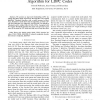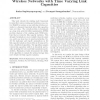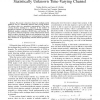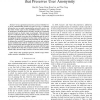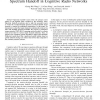ICC
2009
IEEE
14 years 6 months ago
2009
IEEE
— This paper presents a simple method for computing throughputs of links in a CSMA network. We call our method back-of-the-envelop (BoE) computation, because for many network con...
ICC
2009
IEEE
14 years 6 months ago
2009
IEEE
— Vehicle-to-vehicle (VTV) communications are of interest for applications within traffic safety and congestion avoidance, but the development of suitable communications systems...
ICC
2009
IEEE
14 years 6 months ago
2009
IEEE
— The design and analysis of capacity-approaching input signalling for optical intensity channels are presented. Both peak and average optical power constraints are considered in...
ICC
2009
IEEE
14 years 6 months ago
2009
IEEE
—Physical-layer network coding (PLNC) is a novel wireless communication technology, in which multiple transmitters can send signals on the same channel to the same receiver at th...
ICC
2009
IEEE
14 years 6 months ago
2009
IEEE
Abstract— We present an improved thresholding LDPC decoding algorithm which outperforms the Split-Row and original Split-Row Threshold decoders with a small increase in hardware....
ICC
2009
IEEE
14 years 6 months ago
2009
IEEE
— Efficient channel selection is essential in 802.11 mesh deployments, for minimizing contention and interference among co-channel devices and thereby supporting a plurality of ...
ICC
2009
IEEE
14 years 6 months ago
2009
IEEE
This work extends the existing static framework for joint flow control, routing and medium access control (MAC) in random access multi-hop wireless networks to a dynamic framewor...
ICC
2009
IEEE
14 years 6 months ago
2009
IEEE
—We present a detection scheme for multiple-symbol DPSK for use in a statistically unknown time-varying channel. The scheme relies on a parametric representation of the timevaryi...
ICC
2009
IEEE
14 years 6 months ago
2009
IEEE
—A key agreement protocol is a protocol whereby two or more communicating parties can agree on a key or exchange information over an open communication network in such a way that...
ICC
2009
IEEE
14 years 6 months ago
2009
IEEE
— Spectrum handoff occurs when the primary users appear in the licensed band occupied by the secondary users. Spectrum handoff procedures aim to help the secondary users to vacat...

